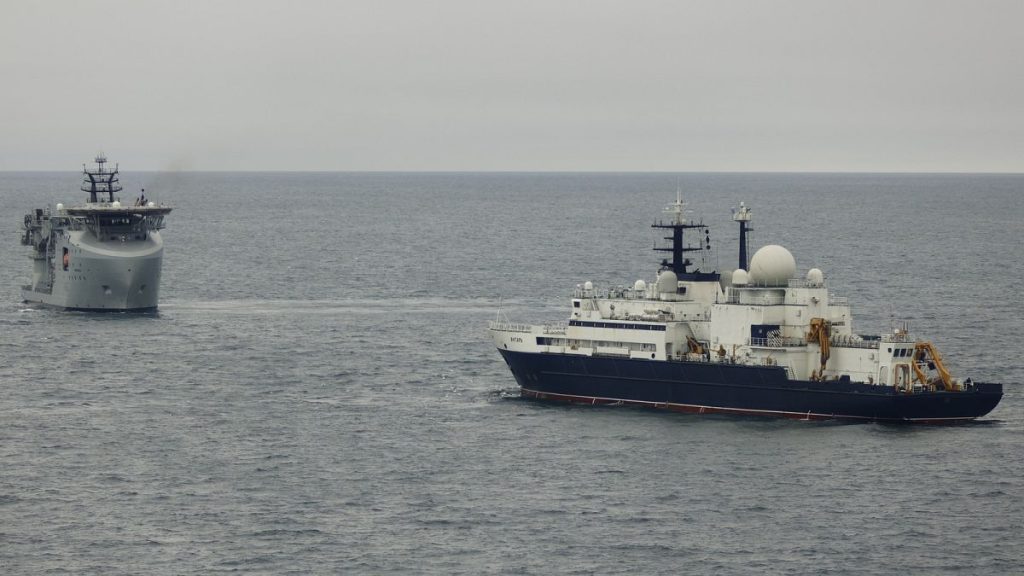The Russian research vessel Yantar, ostensibly engaged in oceanographic research, has become a focal point of suspicion and heightened scrutiny amid rising tensions between Russia and the West. Operated by the secretive Main Directorate of Deep-Sea Research (GUGI), a Russian Ministry of Defence agency, Yantar’s sophisticated capabilities, including the deployment of deep-sea submarines and robots, have led Western officials to believe its true purpose is deep-sea espionage, particularly targeting critical undersea infrastructure.
Yantar’s recent passage through European waters, specifically its presence near UK critical infrastructure, has sparked alarm and a robust response from the Royal Navy. The ship’s activities coincide with a series of suspected sabotage incidents involving undersea cables and pipelines, raising concerns about the vulnerability of Europe’s interconnected systems in the face of potential hybrid warfare tactics. The Royal Navy’s deployment of warships and, unusually, a submarine to shadow Yantar underscores the seriousness with which its activities are being viewed. This overt display of force served as a clear message to Moscow that its actions are being closely monitored and challenged.
Yantar’s presence near known undersea cables, such as the Atlantic Crossing 1, during its transit through the English Channel, further fuels suspicions about its intelligence-gathering objectives. The ship’s ability to map the seabed and retrieve objects raises concerns that it could be collecting data for potential future acts of sabotage. While concrete evidence linking Yantar directly to past sabotage incidents remains elusive, its capabilities and suspicious movements warrant close observation and analysis. The heightened awareness brought about by Yantar’s activities has placed a renewed focus on the vulnerability of undersea infrastructure and the potential consequences of its disruption.
The secretive nature of GUGI, Yantar’s operating agency, adds another layer of complexity to understanding the vessel’s true purpose. GUGI’s direct link to the Russian Ministry of Defence, coupled with its operation of specialized submarines, including nuclear-powered vessels, suggests a potential military dimension to its activities. Yantar’s unique design, enabling it to hover over specific locations and deploy underwater assets, further reinforces its potential role in intelligence gathering and potential covert operations. While officially designated a research vessel, the ship’s capabilities and its observed activities suggest a dual-use potential, blurring the lines between scientific exploration and military intelligence gathering.
Yantar’s recent activities extend beyond UK waters, encompassing previous sightings near critical infrastructure in Irish waters and the Mediterranean Sea. The ship’s involvement in surveying the wreck of the Kremlin-linked cargo ship MV Ursa Major, which sank under suspicious circumstances, raises further questions about its mission objectives. Speculation surrounding Ursa Major’s cargo, potentially including weapons from Syria, adds a geopolitical dimension to the incident and Yantar’s subsequent investigation, highlighting the interwoven nature of Russia’s military and political interests.
The increasing frequency of suspected sabotage incidents targeting undersea cables and pipelines, coupled with Yantar’s suspicious activities, has elevated concerns about the vulnerability of Europe’s critical infrastructure. While definitive proof linking Yantar to these incidents remains lacking, the ship’s capabilities and its presence near these vulnerable points raise legitimate concerns. The use of Russia’s “shadow fleet,” with its opaque ownership and operational structures, further complicates investigations and attribution, providing a layer of deniability for the Kremlin. This ambiguity adds to the challenge of responding to these incidents and deterring future acts of potential sabotage. The ongoing investigation into the damaged Estlink-2 cable exemplifies these complexities, highlighting the difficulties in definitively determining the cause and attributing responsibility.














